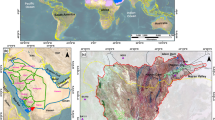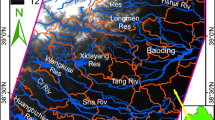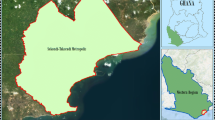Abstract
This study investigates the impact of changing land use and land cover patterns on the surface water deficit in the Rispana River Watershed in Dehradun, India, from 1991 to 2020. Using Landsat TM, ETM+, and OLI images in the GEE platform, the authors assess changes in vegetation, land cover, and land use, as well as climatic variables such as precipitation, evapotranspiration, and temperature. Find that the rapid expansion of urban/built-up areas, from 20% in 2005 to 64% in 2020, is one of the primary reasons for the decline in surface water area. Over the past 30 years, the maximum and average variations of surface water areas have shown a declining trend. In addition, the study find that LST has risen by 2.74 ℃ during the study period, and meteorological parameters have changed with the declining surface water area. Field surveys conducted in the pre- and post-monsoon periods confirm these findings. The study suggest that a proper management policy for watershed restoration and rejuvenation initiatives should be designed and implemented to mitigate the negative impacts of urbanization and overexploitation of natural resources. The findings of this study are relevant not only for the Rispana River Watershed but also for other regions facing similar challenges. The study highlights the need for sustainable land use practices and ecosystem management strategies that balance economic development with environmental conservation. The integration of geospatial data with hydrological, meteorological, and environmental variables at a regional scale can help policymakers and stakeholders make informed decisions for the sustainable management of river watersheds in the face of rapid urbanization and climate change.
Access this chapter
Tax calculation will be finalised at checkout
Purchases are for personal use only
Similar content being viewed by others
References
Alesheikh AA, Ghorbanali A, & Nouri N (2007) Coastline change detection using remote sensing. Int J Environ Sci & Technol 4:61–66. https://springer.longhoe.net/article/10.1007/BF03325962 (2007). https://doi.org/10.1007/BF03325962
Benedict MA, McMahon ET (2012) Green infrastructure: linking landscapes and communities. Island Press
Costanza R, De Groot R, Sutton P, Van der Ploeg S, Kubiszewski I, Turner RK (2014) Changes in the global value of ecosystem services. Glob Environ Chang 26:152–158
Deng Y, Jiang W, Tang Z, Ling Z, Wu Z (2019) Long-term changes of open-surface water bodies in the Yangtze River Basin based on the google earth engine cloud platform. Remote Sens 11:2213. https://doi.org/10.3390/rs11192213
Ermida SL, Soares P, Mantas V, Göttsche FM, Trigo IF (2020) Google earth engine open-source code for land surface temperature estimation from the landsat series. Remote Sensing 12(9):1471. https://doi.org/10.3390/rs12091471
Fahrig L (2003) Effects of habitat fragmentation on biodiversity. Annu Rev Ecol Evol Syst 34(1):487–515
Foley JA, DeFries R, Asner GP, Barford C, Bonan G, Carpenter SR, Snyder PK (2005) Global consequences of land use. Science 309(5734):570–574. DOI: https://doi.org/10.1126/science.1111772
Goldblatt R, You W, Hanson G, Khandelwal AK (2016) Detecting the boundaries of urban areas in india: a dataset for pixel-based image classification in google earth engine. Remote Sens 8(8):634
Gong P, Liu H, Zhang M, Li C, Wang J, Huang H, Clinton N, Ji L, Li W, Bai Y, Chen B (2019) Stable classification with limited sample: transferring a 30-m resolution sample set collected in 2015 to map** 10-m resolution global land cover in 2017. Sci Bull 64:370–373. https://doi.org/10.1016/j.scib.2019.03.002
Gorelick N, Hancher M, Dixon M, Ilyushchenko S, Thau D, Moore R (2017) Google Earth Engine: planetary-scale geospatial analysis for everyone. Remote Sens Environ 202:18–27. https://doi.org/10.1016/j.rse.2017.06.031
Grimm NB, Faeth SH, Golubiewski NE, Redman CL, Wu J, Bai X, Briggs JM (2008) Global change and the ecology of cities. Science 319(5864):756–760
Guo Q, Pu R, Li J, Cheng J (2017) A weighted normalized difference water index for water extraction using Landsat imagery. Int J Remote Sens 38:5430–5445. https://doi.org/10.1080/01431161.2017.1341667
Hulley G, Shivers S, Wetherley E, Cudd R (2019) New ECOSTRESS and MODIS land surface temperature data reveal fine-scale heat vulnerability in cities: A case study for Los Angeles County, California. Remote Sensing 11(18):2136. https://doi.org/10.3390/rs11182136
Johansen K, Phinn S, Taylor M (2015) Map** woody vegetation clearing in Queensland, Australia from Landsat imagery using the Google Earth Engine. Remote Sens App Soc Environ 1:36–49
Joshi M, Levy O, Weld DS, Zettlemoyer L (2019) BERT for coreference resolution: baselines and analysis. Ar**v preprint ar**v:1908.09091
Kumar S, Singh A (2015) Biopesticides: present status and the future prospects. J Fertil Pestic 6(2):100–129
McFeeters SK (1996) The use of the Normalized Difference Water Index (NDWI) in the delineation of open water features. Int J Remote Sens 17(7):1425–1432. https://doi.org/10.1080/01431169608948714
Meng X, Cheng J, Zhao S, Liu S, Yao Y (2019) Estimating land surface temperature from Landsat-8 data using the NOAA JPSS enterprise algorithm. Remote Sens 11(2):155
Millennium ecosystem assessment, M. E. A. (2005) Ecosystems and human well-being (Vol. 5, p. 563). Washington, DC: Island press
Nagendra H, Bai X, Brondizio ES, Lwasa S (2018) The urban south and the predicament of global sustainability. Nat Sustain 1(7):341–349
Oke TR (1982) The energetic basis of the urban heat island. Q J R Meteorol Soc 108(455):1–24
Rokni K, Ahmad A, Selamat A, Hazini S (2014) Water feature extraction and change detection using multitemporal Landsat imagery. Remote Sens 6:4173–4189. https://doi.org/10.3390/rs6054173
Seto KC, Güneralp B, Hutyra LR (2012) Global forecasts of urban expansion to 2030 and direct impacts on biodiversity and carbon pools. Proc Natl Acad Sci 109(40):16083–16088
Sobrino JA, Raissouni, N, Li ZL (2001) A comparative study of land surface emissivity retrieval from NOAA data. Remote Sens Environ 75(2):256–266. https://www.sciencedirect.com/science/article/pii/S0034425700001711#:~:text=https%3A//doi.org/10.1016/S0034%2D4257(00)00171%2D1
Stroppiana D, Antoninetti M, Brivio PA (2014) Seasonality of MODIS LST over Southern Italy and correlation with land cover, topography, and solar radiation. Eur J Remote Sens 47:133–152. https://doi.org/10.5721/EuJRS20144709
Trianni G, Angiuli E, Lisini G, Gamba P (2014) Human settlements from LandsatLandsat data using google earth engine. In Proceedings of the 2014 IEEE International Geoscience and Remote Sensing Symposium (IGARSS), Quebec City, QC, Canada, 13–18 July 2014; pp. 1473–1476. https://doi.org/10.1109/IGARSS.2014.6946715
Xu H (2005) A study on information extraction of water bodies with the modified normalized difference water index (MNDWI). J Remote Sens-Bei**g 9(5):595
Yang H, Wang Z, Zhao H, Guo Y (2011) Water body extraction methods study based on RS and GIS. Procedia Environ Sci 10:2619–2624. https://doi.org/10.1016/j.proenv.2011.09.407
Zamil KS, Mim & M. A. (2018) Gis-based analysis of changing surface water in Rajshahi city corporation area using support vector machine (svm), decision tree & random forest technique. Mach Learn Res 3(2):11
Zhou Y, Dong J, ** algorithms: a comparison of water-related spectral indices and sensors. Water 9(4):256
Author information
Authors and Affiliations
Corresponding author
Editor information
Editors and Affiliations
Rights and permissions
Copyright information
© 2023 The Author(s), under exclusive license to Springer Nature Singapore Pte Ltd.
About this paper
Cite this paper
Kumar, A., Nandi, K.K., Dutta, S. (2023). Effects of Anthropogenic Stress and Water Security in Himalayan Urban River Watershed. In: Dutta, S., Chembolu, V. (eds) Recent Development in River Corridor Management. RCRM 2022. Lecture Notes in Civil Engineering, vol 376. Springer, Singapore. https://doi.org/10.1007/978-981-99-4423-1_14
Download citation
DOI: https://doi.org/10.1007/978-981-99-4423-1_14
Published:
Publisher Name: Springer, Singapore
Print ISBN: 978-981-99-4422-4
Online ISBN: 978-981-99-4423-1
eBook Packages: EngineeringEngineering (R0)




